Posts Tagged ‘smog’
Chris Turner Becomes First State Representative to Ask EPA for new DFW Air Plan
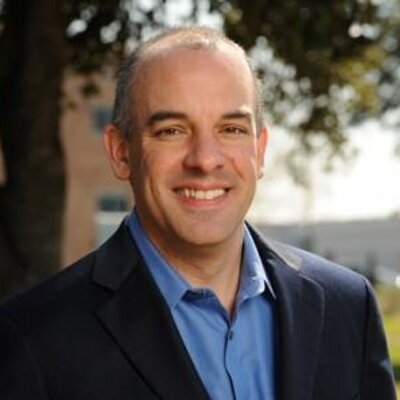 State Representative Chris Turner, whose District 101 spans west Grand Prairie and east Arlington between Dallas and Fort Worth became the first state elected official to urge EPA to reject the current state anti-smog plan for DFW and substitute one of its own.
State Representative Chris Turner, whose District 101 spans west Grand Prairie and east Arlington between Dallas and Fort Worth became the first state elected official to urge EPA to reject the current state anti-smog plan for DFW and substitute one of its own.
In a letter to EPA Chief Gina McCarthy, Turner used language echoing the sentiments of US Congresswoman Eddie Bernice Johnson and Congressman Marc Veasey.
"While I hope that the TCEQ will take the public comments it received by EPA, the Texas Medical Association, and others into consideration and require additional emissions controls in the final SIP revision it submits to EPA, I ask you to consider rejecting the state's plan use of a Federal Implementation Plan if your agency decides that the final SIP revision is insufficient and the state will not negotiate in good faith."
The entire letter can be read here.
Besides Johnson and Veasey's letters, Dallas County and the City of Dallas have voted in favor of resolutions condemning the currently proposed plan has being inadequate. More cities and counties are expected to pass similar resolutions as elected bodies come back from summer breaks.
Members of the DFW Clean Air Network (DFW CAN) – Downwinders at Risk, the Sierra Club, Beyond Coal, the Texas Campaign for the Environment, Mansfield Gas Well Awareness and Livable Arlington – are also out and about obtaining letters like Turner's from other state and federal elected officials.
Turner's district is directly downwind of the Midlothian cement plants and includes numerous natural gas wells and facilities. Gas sources are now the fourth largest contributor to DFW smog.
According to EPA, the state plan arrived at the EPA's doorstep August 8th, but it's already DOA.
Although ozone season is far from over and it's been a relatively mild "season" so far, we know in its second full year out of the three years allotted for success, the state air plan will, at best, have brought down ozone levels by 1 ppb from 2015 levels, to 80 ppb. We're supposed to be at 75.
The parrot is dead. We're just waiting for the state to admit it – or the EPA to shut the farce down.
Meanwhile, the more political support on the ground in DFW for an EPA alternative that might actually reduce emissions from major sources in North Texas like gas, cement kilns, and coal plants, the more likely it is for the Agency to accept the challenge, and endure all the pushback from Austin it'll get if it decides to take over the job.
If you're interested in trying to get your city, county, or state or federal elected officials to join the band wagon and reject the state plan, write or call us and we'll work with you in getting something accomplished that can add to the momentum.
Bring the East Texas Coal Plants into DFW’s Smog “Non-Attainment Area” and See How Long They Last……
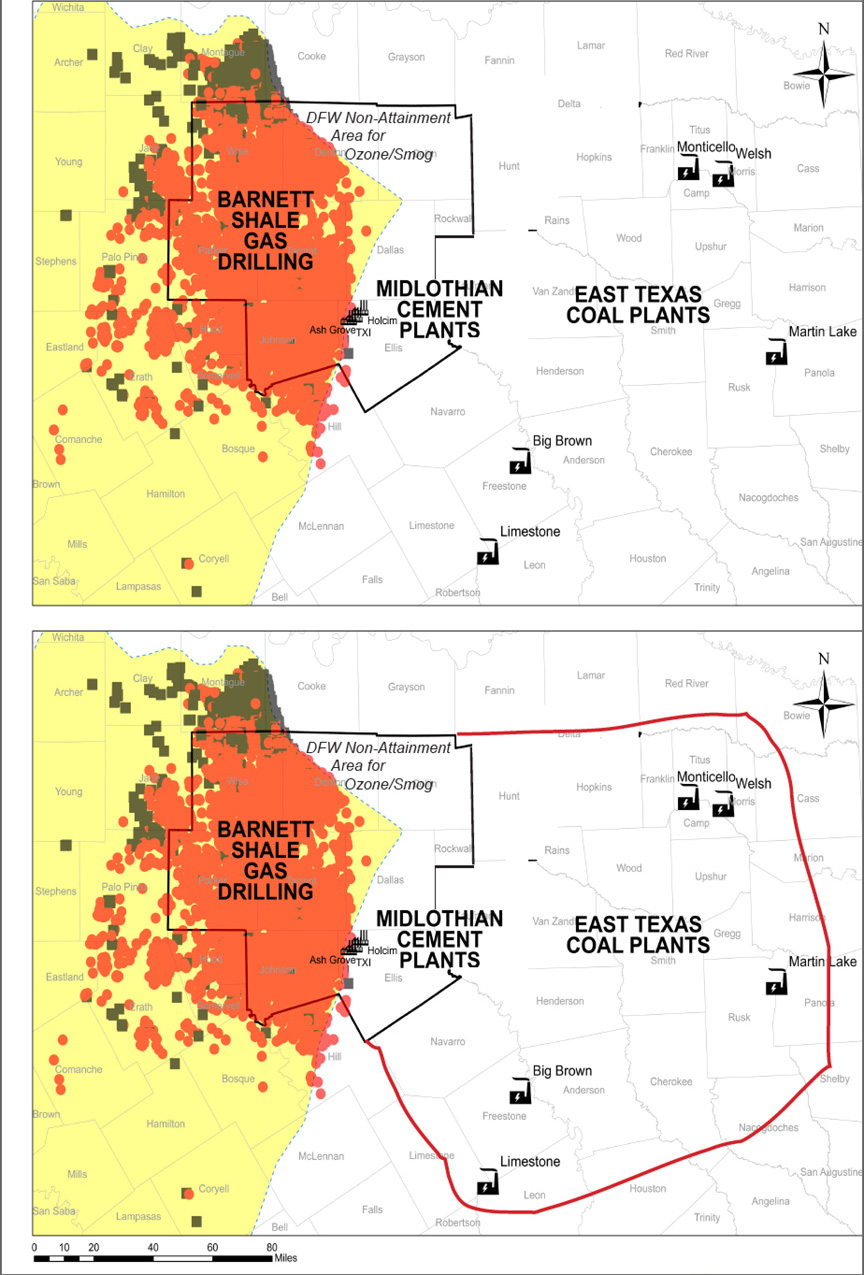 Want the Coal Plants to Face the Kind of Regulation
Want the Coal Plants to Face the Kind of Regulation
They've Been Avoiding for Decades?
Click here and send a formal comment letter demanding the coal plants
be included in the new DFW non-attainment area for smog.
Even as we're all waiting to see what EPA decides to do about the current Texas air plan for DFW under the current 75 ppb ozone standard, the regulatory process is gearing-up to administer the new 70 ppb standard.
One of the things which must be decided by the EPA are what geographical boundaries to use for the new standard when it comes to the DFW airshed and its chronic smog condition. Should they stick with the current 10-County configuration or should it be different and/or more inclusive?
The history of DFW's smog fight is a lengthy chronicle of bringing new counties into the fold despite official resistance. Originally, the DFW non-attainment area was only Tarrant, Dallas, Collin and Denton. Then Rockwall, Parker, and Johnson Counties came in because of their commuter traffic.
Downwinders had to petition the EPA to bring Ellis County and its cement industrial complex into the non-attainment area early in this century after being told repeatedly by state officials that its pollution had no impact on DFW air quality.
More recently, the state argued against the inclusion of Wise County, despite its huge inventory of oil and gas pollution, population of commuters, and more than likely, the highest ozone levels of anywhere in North Texas. EPA decided to bring it in anyway.
We're once again at a crossroads, and it could be the most significant one in a decade.
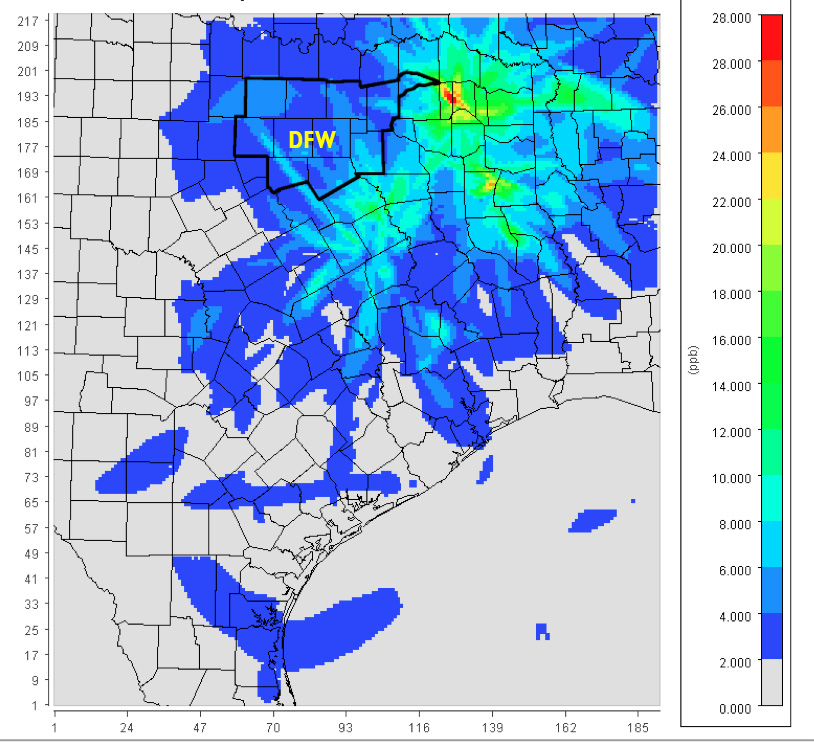 New evidence shows the huge impact the East Texas coal plants have on DFW air quality. Every scenario run by the UNT Engineering Department with the state's own DFW air computer model as part of Downwinder's Ozone Attainment Project demonstrates there's no more effective smog fighting strategy than reducing or eliminating the pollution from these coal plants.
New evidence shows the huge impact the East Texas coal plants have on DFW air quality. Every scenario run by the UNT Engineering Department with the state's own DFW air computer model as part of Downwinder's Ozone Attainment Project demonstrates there's no more effective smog fighting strategy than reducing or eliminating the pollution from these coal plants.
In fact, with a few other measures within the DFW area itself, controlling or eliminating their emissions could bring us in compliance with the 75 ppb standard, something that's not likely to happen otherwise.
Why is it so important to officially bring them into the DFW non-attainment area? Because major sources of pollution like coal plants are regulated differently inside than they are outside the area.
Right now, many DFW businesses are having to pay to operate and maintain pollution control equipment although most emit a tiny fraction of the pollution coming from the coal plants. That's because they're located in one of the ten counties in the DFW non-attainment area. They're held to a higher standard of control than their peers doing business outside those ten counties.
On the other hand, despite their large contribution to DFW's chronic ozone problem, the East Texas coal plants remain untouched by the same regulations and are not held to that higher standard. What sense does that make?
As much sense as it made to keep the cement plants out. As much sense as it made to try and exclude Wise County.
As per usual, the EPA is letting the state have first crack at defining a new DFW smog zone. The state has decided to leave the boundaries the way they are.
 Now, it's your turn to comment on that state decision, and tell Austin and the EPA – which will review the State's recommendations – what you think needs to happen.
Now, it's your turn to comment on that state decision, and tell Austin and the EPA – which will review the State's recommendations – what you think needs to happen.
The state is accepting comments on its decision until April 15th. This time, you can send your comments directly by e-mail instead of having to go through the official Texas Commission on Environmental Quality website
If you want to use our ready-to-send letter, all you have to do is CLICK HERE , sign the letter and add your own comments if you want. Then one more click and it's on it's way to Austin.
If you want to write your own comments:
EMAIL: kristin.patton@tceq.texas.gov
SNAIL MAIL: Kristin Patton, MC 206, State Implementation Plan Team, Office of Air, Texas Commission on Environmental Quality, P.O. Box 13087, Austin, Texas 78711-3087,
FAXED:(512) 239-6188.
All comments should reference "2015 Ozone NAAQS Designation Recommendations."
State Re-Submits Illegal DFW Smog Plan, Dares EPA to Reject It

(Dallas)– In an unprecedented rebuke to the Environmental Protection Agency, Texas has refused to provide critical data EPA says it needs to approve the state’s controversial anti-smog plan for DFW, which requires no new pollution controls despite more than two decades of chronic bad air.
Texas' refusal to cooperate with EPA puts its plan, scheduled to be approved by the Texas Commission on Environmental Quality December 9th, on a collision course with the federal agency.
Although EPA gives state governments authorization to write smog plans for their own metropolitan areas, it still has final approval based on criteria listed in the Clean Air Act. EPA disapproval of the State's DFW plan would trigger the possibility of a federal takeover of the air planning process.
That would be fine with local air quality activists, who've been pushing for the EPA to take over the job of writing a new clean air plan for North Texas since the State unveiled its first draft last year. They say TCEQ's official position that smog isn't harming public health means the Commission can't be trusted to write an effective anti-smog plan. When the state announced a plan imposing no new controls on any sources of air pollution despite DFW being in continual violation of the Clean Air Act for the last quarter century, they feel they were proven right.
"It's as if the state is too embarrassed to do what EPA is asking for fear of finding facts that don't match its ideology," said Jim Schermbeck, Director of the local clean air group, Downwinders at Risk.
He noted among the most important missing items in the State’s final plan published November 20th was a "Reasonably Available Control Technology"(RACT) study for the Midlothian cement plants, as well as answers to the impact of controls on other sources like the East Texas coal plants and oil and gas facilities that EPA posed in its eleven pages of official comments on the first draft last February. Application of modern pollution controls to all major sources of air pollution in a smog-plagued region is a key component of the Clean Air Act.
In official comments last February, EPA specifically requested the state perform a new study of what kind of smog controls should be required of the three Midlothian cement plants immediately south of DFW. EPA warned lack of such a study would mean the plan would be disapproved:
"Failure to conduct a thorough RACT analysis for cement kilns which would include appropriate emission limits would prevent us from approving the RACT portion of the attainment plan submittal.”
By turning-in the same version of the technology review originally criticized by EPA, without any new additional analysis, the TCEQ began a bureaucratic game of "Chicken," daring the EPA to deny approval.
"If you're EPA, I don't see how you take this any other way than a big raised middle finger from Austin," said Schermbeck. "The question is: What's EPA gonna do about it now?"
Also missing in the final state version are any responses to other EPA's concerns and questions about the plan's chances of actually lowering smog levels and the possibilities of reducing smog with new controls on other sources, such as,
“How would a reduction in NOx emissions from utility electric generators in the counties closest to the eastern and southern boundaries of the DFW area impact the DFW area?”
EPA was already openly skeptical about the chances of the state’s plan succeeding without requiring any additional cuts in pollution. Stating “it would be difficult to see” how the plan meets its required 2017 deadline, the Agency concluded “we believe it is likely that additional reductions will need to be included to demonstrate attainment.”
TCEQ’s resubmitted plan doesn’t have any additional reductions. Failure of a state plan to show how it can reach the smog standard by 2017 would be cause for EPA to assume the job itself.
Evidence suggests the state is purposely overlooking the air quality benefits of controls on large industrial sources of air pollution affecting DFW.
In late October, Downwinders at Risk released a new study of its own. It paid for University of North Texas engineers to build a clone of the State’s DFW air computer model and run a series of control scenarios the state hasn’t performed in almost a decade. Using the TCEQ’s own numbers it showed new controls on the cement kilns, coal plants, and gas compressors in the Barnett Shale would lower smog levels enough to meet the current federal smog standard. DFW hasn’t met a federal standard for smog since once was created in 1991.
Dismissing the results as “limited,” TCEQ officials nevertheless agreed with them – since they were based on their own model. The State argues those new controls are not yet technically or economically feasible – despite their being commonplace around the world, in the US, and even in Texas.
This question is one of the keys to the standoff with EPA: are the proposed new controls for industry “Reasonably Available” or not? If they are, they must be included in the air plan. If not, they remain off the table. EPA makes the first call on a definition, and any aggrieved party can sue to expand or contract it.
Because it’s a national hot spot for smog, DFW is only one of a handful of US metro areas that even had to submit a clean air plan this last cycle. EPA computer modeling predicts the area will still be in violation of the Clean Air Act in 2015 unless significant reductions in pollution are made.
This summer saw the North Texas regional smog average rise twice in one hot August week, retreating from gains made during last year’s cooler, wetter summer. DFW once again has higher annual smog levels than Houston. Both cities remain well above the current standard.
According to the American Lung Association, the 10 county DFW “non-attainment” area for smog includes approximately 150,000 asthmatic children, 350,000 adults with asthma, and over 600,000 adults with cardiovascular disease or COPD – all of whom are at risk from the region’s bad air.
“The lungs and lives of seven million residents are being held hostage by a state government that doesn’t think smog is a problem and isn’t willing to require new pollution controls to reduce it, “ Schermbeck pleaded
“Expecting the State of Texas to enforce Environmental laws in 2015 is like expecting the State of Mississippi to enforce Civil Rights laws in 1965. Our only hope is federal intervention.”
DFW One of Only Ten Areas Nationwide Not Expected to Meet New Smog Standard by 2025
 There was a lot of coverage of last week's announcment of a new, more protective national smog standard by EPA. Most of it centered on the reaction by both sides that it was either not enough progress (public health advocates), or Western Civilization was about to collapse under the weight of all the controls necessary to meet the standard (National Chamber of Commerce, et al.).
There was a lot of coverage of last week's announcment of a new, more protective national smog standard by EPA. Most of it centered on the reaction by both sides that it was either not enough progress (public health advocates), or Western Civilization was about to collapse under the weight of all the controls necessary to meet the standard (National Chamber of Commerce, et al.).
But if you read deeper into the articles, many of them mentioned computer modeling EPA had already done that demonstrated, given current trends, only 14 counties, representing 10 separate areas, wouldn't be able to meet the new standard by the target year of 2025. Unfortutantely, none of those articles mentioned which 14 counties, or which 10 areas.
Now, given all that you already know about our state and regional track record for meeting clean air deadlines, your first question might be: how many of those are in Texas? We'll give you a minute or two to start a pool and pick a number….
And the answer is: Three. Brazoria and Harris Counties in the Houston "non-attainment area" for smog, and Tarrant in DFW's non-attainment area. (The ten areas are: Baltimore, Dallas-Fort Worth, Denver, Fort Collins, Houston, Louisville, Milwaukee, New Haven, New York, and Pittsburgh).
Of course, for the purposes of regional smog record-keeping, EPA doesn't separate Tarrant County numbers from Dallas County, or Denton County, or any of the other nine counties in the non-attainment area. If one monitor is out of compliance in the area, the whole region is considered in violation. So EPA is conceeding that both DFW and Houston will still continue to be in continual violation of the Clean Air Act for another decade.
This is discouraging but not surprising. The State refuses to put new-generation controls on large major polluters like the Midlothian cement plants, East Texas coal plants, and gas production facilities, while painting the rosiest scenarios with its own modeling.
But this new revelation means it's that much more important to get EPA to override the state and act now to include controls on those major polluters, while the current smog plan is in the pipeline. It may be the only chance we have in the next 5-10 years to adequately address these sources. This can only be done if the EPA decides to revoke Texas' authority to write and implement these plans – to commit to a Federal Implementation Plan of its own.
PLEASE….
1) Sign our Change.Org petition urging the EPA to reject the state's clean air plan for DFW and substitute one of its own, and
2) Send an e-mail to the Chief EPA administrator in Washington and the Regional Administrator here in Dallas saying you want them to take responsibility for a new DFW air plan.
Thanks.
US Cement Plant Using SCR Pollution Control Device Achieves 80% Reduction. Texas Says It’s Still Not Feasible.
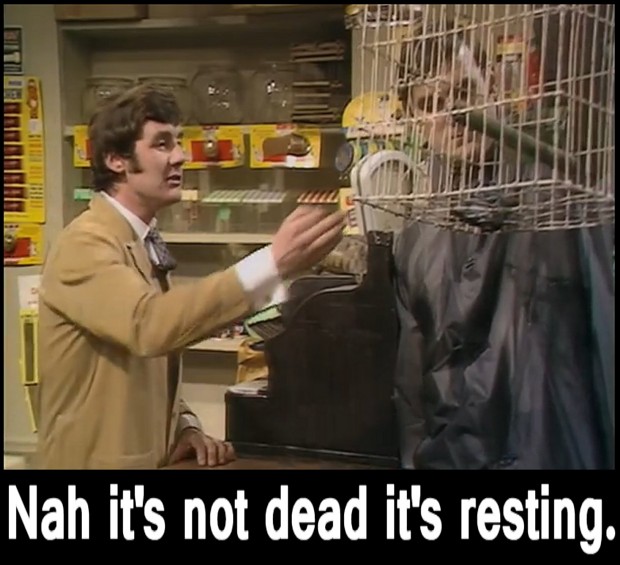 EPA has released the results of the first test of a full-scale Selective Catalytic Reduction (SCR) unit on a US cement plant and the numbers look good.
EPA has released the results of the first test of a full-scale Selective Catalytic Reduction (SCR) unit on a US cement plant and the numbers look good.
As many of you know, SCR is just an industrial-sized version of the catalytic converter in your car. It can capture up to 90% or more of the smog-forming pollution from a cement plant. In use on cement kilns since 2001, there are at least a half a dozen cement plants in Europe that use SCR successfully, but the technology has been slow to arrive in the US because of regulatory laziness and industry resistance.
But after 15 years, that's finally changing.
in 2013, LaFarge Cement entered into a consent decree with the EPA and the US Justice Department as part of a settlement over a string of environmental violations, including excessive smog-forming Nitrogen Oxide (NOX) emissions. As part of that settlement, Lafarge was to retrofit its Joppa, Illinois "dry process" cement kiln with an SCR unit, record its effectiveness during stack testing, and report on the results of those tests by 2015.
This last week, those results were finally made available by EPA and they show SCR was able to reduce NOx by 80%.
That's approximately twice as effective as SNCR technology, (Selective NON-Catalytic Reduction), the current pollution control device for NOx most often used in U.S. cement plants.
Moreover, according to LaFarge, "the SCR control technology performed well and no operational problem was encountered."
In fact, the control technology worked so well, LaFarge is now getting a permit from the Illinois state environmental agency to operate SCR past the EPA-mandated settlement period.
But while LaFarge is getting its SCR permit, Holcim's Midlothian cement plant has already applied and been granted one by the Texas Commission on Environmental Quality for construction and operation of its own SCR unit. It should be up and running by this time next year.
So that makes two U.S. cement plants with permits to run full-scale SCR units. One that was forced into the choice by EPA and now wants to keep using it, and another voluntarily adding it.
But according to the TCEQ, even though it gave a permit to Holcim to install SCR, and even though Holcim's SCR unit will be operational in a year, and even though the LaFarge test was a success, and even though SCR has been used for 15 years by European cement companies – SCR is "not economically or technically feasible." That's exactly what the Commission said in response to comments from both citizens and the EPA in its new clean air plan for DFW a couple of months ago.
That's right. One the one hand the Commission has granted a permit to Holcim to build an SCR unit in its own backyard, and on the other it's still calling the technology infeasible. It's the stuff of Monty Python sketches.
And that's not all. There is no mention of the Holcim Cement SCR permit in the TCEQ's own official arguments against SCR in its DFW clean air plan. Not one. Since Holcim's building of an SCR unit would tend to empirically disprove TCEQ's contention that the technology wasn't practical, the state just pretends it's not happening. As with climate change and smog, any facts that conflict with the pre-determined ideologically-correct premise must be ignored.
Presumably, Holcim is building the SCR unit because it's made the business judgment that the technology is not only both economically and technologically feasible, but beneficial to the company's bottom line. Presumably LaFarge is pursuing a permit for its SCR unit because it has made the same practical decision. Yet, in a strange role reversal, a Texas state government agency is now telling business it's making the wrong choices. It's overruling the industry's decision to reduce pollution through SCR use by saying "not so fast."
This is how bad its gotten: the Texas approach to clean air is now so backwards that the cement industry is more aggressive about reducing pollution than Austin.
So how many U.S. cement plants have to be operating with SCR before the State of Texas concludes it's a feasible technology? Two? Four? A Dozen?
Fortunately, the TCEQ isn't the last word on this. The Clean Air Act says any and all reasonably available technology must be used on major pollution sources like the Midlothian cement plants when a clean air plan is being drafted. TCEQ hasn't done that. We think they're breaking the law. There are signs that EPA thinks so as well.
EPA is ultimately in charge of enforcing the Clean Air Act, and if it doesn't do it correctly, then the courts step in.
The best hope for safe and legal air in DFW is for EPA to rigorously enforce the law. The State of Texas will not do so. If you agree then please take a minute to:
1) sign this petition to EPA
2) Send this e-mail to EPA
Thanks.
Going Backwards: DFW’s Annual Smog Average Went Up Twice in Two Days Last Week
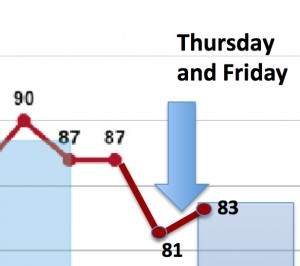 State officials and industry PR types thought they'd caught a break last summer when two things produced a much lower annual smog average, called a "Design Value."
State officials and industry PR types thought they'd caught a break last summer when two things produced a much lower annual smog average, called a "Design Value."
Since it's a three-year rolling average of smog numbers, past years roll off as new ones come on. Smog numbers from 2011 that had been so high they'd sent the average soaring, were finally rolling off and wouldn't be included in the average.
Second, unusually cooler temperatures and rain kept a new round of numbers lower. Combined, these factors resulted in a significant decrease in the smog average for 2014.
But in 2015, a more typical summer, or at least August, is bringing the average back up (Over 60% of the 100 highest recorded levels of smog this summer occurred in the last 30 days). Smog levels are higher across the board this year than last. There are more monitors recording more "exceedences" of the national smog standard. Leading them all is the Denton monitor, which saw ozone levels rise on Thursday and then skyrocket on Friday. The numbers were so high on both days they moved the needle of the annual smog average, the DFW Design Value, up from 81 to 82 parts per billion (ppb) on Thursday and up to 83 ppb on Friday. The standard is 75 ppb.
Even though Houston has recorded higher smog numbers than DFW this year, 2014's lower smog numbers was even more anomalous for that city than for North Texas. Last year's much lower numbers in the Bayou City are canceling out this year's much higher numbers. So that in 2015, DFW's Denton monitor's annual average of 83 ppb is the highest in the State of Texas.
And that means that according to the official accounting of the Clean Air Act, DFW has dirtier air than Houston. And not for the first time.
It also means we're rolling backwards in terms of air quality progress. With at least a whole month of "ozone season" to go, DFW's smog average is now only a little lower than it was in 2009. It would only take one or two more bad days to raise the average again.
This is the second time in four years that DFW's smog average has increased during the implementation of a state clean air plan for the area. Neither plan required new controls on large industrial polluters significantly contributing to the problem, like the gas industry, East Texas coal plants, and Midlothian cement kilns. There may be some connection there.
Given the state's stellar two decade-old track record of never meeting a clean air plan deadline, its latest plan was always likely to fail. But a federal court roll back of the deadline to get to the 75 ppb standard at all DFW monitors, from 2018 to 2017, plus these new 2015 smog numbers, make it DOA in the real world.
However, in the regulatory world governing these things officially, the plan is still being reviewed by the EPA and, believe it or not, could get approved if citizens don't make a big stink.
That's why you need to sign our Change.org petition to EPA to reject the state's plan and send an email to EPA officials requesting they write a new clean air plan instead of the state of Texas.
Many clean air advocates cautioned that 2014 should be seen as a outlier, and this summer is justifying that caution. If the experts are right, climate change will mean future summers will be more like 2011 than 2014. We've got to have a more realistic approach to the goal of safe and legal air. The State of Texas will not provide that. EPA can.
The Chinese Silent Spring Moment?
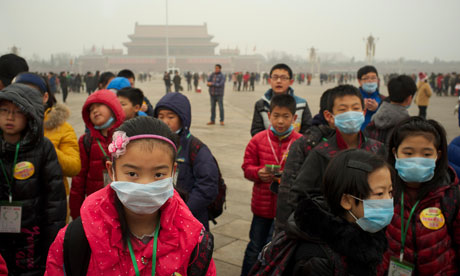 Every once in a while, even now, in the midst of our electronic surroundsound calliope, popular culture can freeze on a moment of some social significance that strikes a collective nerve. For the US this summer it was Ferguson, Missouri. For China, it might just be this last weekend's debut of a documentary about the horrible air pollution that envelopes life in much of that country.
Every once in a while, even now, in the midst of our electronic surroundsound calliope, popular culture can freeze on a moment of some social significance that strikes a collective nerve. For the US this summer it was Ferguson, Missouri. For China, it might just be this last weekend's debut of a documentary about the horrible air pollution that envelopes life in much of that country.
"Under the Dome" is the video manifesto of a Chai Jing, a former Chinese television reporter who didn't give much thought to the brown haze she was breathing, until she was breathing for two.
"Back then, she says, she paid little attention to the smog engulfing much of China and affecting 600 million people, even as her work took her to places where the air was acrid with fumes and dust.
“But,” Ms. Chai says with a pause, “when I returned to Beijing, I learned that I was pregnant."
“I’d never felt afraid of pollution before, and never wore a mask no matter where,” Ms. Chai, 39, says in the video. “But when you carry a life in you, what she breathes, eats and drinks are all your responsibility, and then you feel the fear.”
Her film was posted online Saturday and within just a news cycle or two caused such an uproar and reaction that China's minister of environmental protection compared it to Rachel Carson's “Silent Spring,” the landmark exposé of chemical pollution published in the early 1960's that led to the banning of DDT in the United States. By Sunday afternoon, over 25,000 comments from Chinese citizens had been left at her website, including ones like this that any frustrated downwinder can relate to: “In this messed-up country that’s devoid of law, cold-hearted, numb and arrogant, (her film) is like an eye-grabbing sign that shocks the soul.”
Jing's approach to the material is partly responsible. This isn't a detached observational third-person narrative of the problem. It's her own memoir that uses science and investigative reporting as tools to explore the links between her daughter's benign tumor and the dirty air she believes might have caused it, and so many other health problems. It;s a personal story she probably ould not have told as a member of the official Chinese television news network where she was employed for many years.
We've noted for some time that the most radical environmentalists on the planet aren't Earth Firsters in Colorado, or Greenpeace activists in Europe, but angry Chinese parents, who, over the last decade, have kidnapped the managers of polluting facilities and destroyed whole chemical plants suspected of causing widespread health problems in villages. Undistracted by a mind-numbing, soul-killing regulatory regime like the Texas Commission on Environmental Quality that offers a veneer of control, there's no bureaucratic weapons available to most Chinese citizens when they're being shat on by industry. You either accept it or you don't. Increasingly, when it comes to the harm being imposed on their children, many don't. Especially the mothers.
Take a look at the membership of any front line environmental group. It's populated and administered mostly by women. It was women like Rachel Carson who took on the patriarchy of "modern science" to begin the discussion on environmental health. It was Los Angeles moms in the 1950's who organized the first anti-smog groups and began the modern fight for cleaner air. It was Lois Gibbs, the mother, at Love Canal who committed her own act of kidnapping when she found out her house was built on top of a toxic waste dump. It's women who lead the anti-fracking groups around the country today and here in the Barnett Shale. It's women who founded and make up 90% of Downwinders' board.
Environmental activism may be one of the purest forms of modern feminism there is, both in content and organization. And it's a woman, a mother, who may have once again held up a mirror to a culture, one that hosts a full 6th of the world's population, and asked what the hell are we doing to our species by exposing ourselves to so many obvious poisons.
Both Gas Industry Spinmeister and Mansfield Compressor Spew During Thursday’s EPA Hearing
 There was at least one truth uttered by Steve Everley, the professional PR spokesperson for Energy in Depth, itself the PR arm of the Gas Industry, during his testimony at last Thursday's EPA ozone standard hearing in Arlington:
There was at least one truth uttered by Steve Everley, the professional PR spokesperson for Energy in Depth, itself the PR arm of the Gas Industry, during his testimony at last Thursday's EPA ozone standard hearing in Arlington:
"…natural gas producers will be significantly impacted by EPA’s proposal to reduce the National Ambient Air Quality Standard for ozone from 75 parts per billion to between 65 and 70 ppb."
Indeed. At the rate things are going in Austin and DC, it might be the only thing to impact the industry's large emissions of pollution for many years to come. Left unsaid by Everley was why the industry would be impacted by such a lower ozone standard – because in many parts of the country now, including the DFW area, smog-forming pollution from the gas industry is contributing significantly to higher ozone levels.
Even the governmental affairs branch of the gas industry, otherwise known as the Texas Commission on Environmental Quality, admits that facilities like compressors, storage tanks, pipelines, and de-hydrators found by the thousands in the western part of the Metromess contribute more smog-forming Volatile Organic Compounds (VOCs) than all the "on-road" vehicles in North Texas combined. This is true not only at the present time, but will be true at least three years into the future, according to TCEQ's own estimates.
Gas facilities also account for the third largest source of smog-forming Nitrogen Oxide pollution in DFW, according to TCEQ numbers included in their recent air plan submitted to EPA – only a ton per day less than all "non-road" vehicles in North Texas like construction equipment, and well ahead of "point sources" like the Midlothian cement kilns and local power plants.
In all, TCEQ predicts that 35,335 tons per year of smog-forming pollution will still be coming from the region's gas industry in 2018. That's a lot. It's so much that, as the TCEQ also demonstrates with its computer modeling, even a tweak here and there in gas pollution estimates can make big differences in the levels of ozone at monitors in places like Denton and Keller and Eagle Mountain Lake – traditionally the worst-performing air quality monitors in North Texas.
And that's why a lower ozone standard is a threat to the industry. The very air quality monitors the industry affects most with its pollution are the ones driving the region's high smog levels. Lowering the ozone standard means it would have to spend money to reduce those emissions significantly. It means it would have to spend money to prevent the kind of huge "accidental" releases of smog-forming pollution released by the Mansfield compressor on Thursday even while Steve Everley was testifying to EPA.
After giving her own testimony to EPA on Thursday morning, Earthworks' Sharon Wilson and Mansfield Gas Well Awareness board member Lance Irwin headed out to the Summit Midstream Partners Compressor Station behind Mansfield's Performing Arts Center, with an infrared, or FLIR "thermal imaging" camera. Such a device is capable of recording the kinds of VOC emissions that are often smelled and inhaled by surrounding residents, but can't be seen with the naked eye.
The Summit compressor and the two nearby Eagleridge gas wells have been the scene of many different complaints from the surrounding Mansfield neighborhood – everything from airborne foam landing in backyards to oily deposits landing on car finishes. On Thursday, Wilson and Irwin were responding to a new series of complaints about awful smells. When they showed up, what the two recorded was a massive "emergency blowdown" (versus the "planned" kind). While filming the event, Wilson suffered health effects familiar to gas facility neighbors and was overwhelmed by the obvious hydrocarbon fumes. Once you see her video, you understand why:
Such a blowdown was exactly what Lance Irwin had warned the Mansfield City Council about only three days before, during comments directed at slowing down or denying the permit for a new compressor, 34 wells, 12 tanks and a assortment of other facilities at an Edge pad site near Debbie Lane in town. He pointed out that industry and government estimates about emissions never take these kind of catastrophic events into account – form a short-term toxic exposure perspective, or as it turns out, from an air quality, smog-creating perspective. And he's right.
In this regard, these kinds of accidents are no different than the infamous industrial "burps" from refineries and chemical plants along the Houston Ship Channel that lead to smog spikes downwind. There are 650 large compressor stations in the DFW "non-attainment" area. How many are experiencing blowdowns on any given day? How many are affecting ozone levels in the spring and summer? The TCEQ estimates included in its DFW air plan don't even try to quanify them.
Because gas facilities like compressors are subject only to "standard permits," are located diffusely around a region, and don't officially emit a de minimus amount of air pollution, they're not subject to the federal rule of off-setting. That's when a new polluting facility locates in an already smoggy area like DFW and has to pay to cut smog pollution elsewhere if it wants to emit the stuff itself. If a new cement plant or power plant were to locate in DFW, it would have to pay to reduce a ton and a half of smog-forming pollution for every ton it wanted to release. Gas facilities don't have to do this – even though collectively they emit more smog-forming pollution than all the cement plants and power plant in the non-attainment area!
EPA has tried to argue that a company's different facilities are all tied together and should be counted as a single source, and so subject to off-setting regulations. But the courts have ruled against them.
Rising gas industry pollution and the absence of any official brake on its growth like off-setting is a large reason, maybe the primary reason, why DFW hasn't seen the kind of air quality progress it should have by now. Until this last summer's cooler and wetter weather gave us relief, ozone levels had been stagnating or even rising since 2009 – or about the time the industry invaded North Texas in large numbers. There's no question that had the Barnett Shale boom not happened, we'd have much cleaner air by now.
But it did and we don't. And so that's why a lower ozone standard is perhaps the only way that the gas industry will ever be forced to clean-up its act – especially on the widespread regional level we require to get to safe and legal air. Just like it has with the Midlothian cement plants, the need for lower smog levels can force the state's and industry's to act to add controls. It's a long-term fight, but one of the only paths to across-the-board change versus the city-by-city slog activists have had to rely on.
National Resources Defense Council lawyer John Walke has a great takedown of Steve Everley's spin on Thursday. And the tireless cross-country DeSmogblog reporter and photographer Julie Dermansky has a good read on the Mansfield fight that you should check out. But the most compelling rebuttal to both industry PR and local governments who want to ignore their own responsibility in this mess is probably Wilson and Irwin's two and a half minutes of video.
Why DFW Residents Should Speak in Favor of a Lower Smog Standard at Thursday’s EPA Public Hearing in Arlington
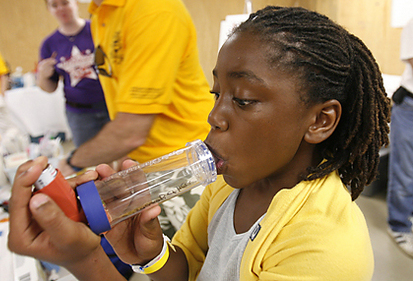
All Day NATIONAL Public Hearing on a New Federal Ozone Standard
Thursday, January 29th, 9am to 7:30 pm
Arlington City Hall, 101 W. Abram
There are only three national public hearings on the possibility of lowering the national federal ozone, or smog, standard. One is in Washington DC, another is in Sacramento, California and the third is right here in Arlington, Texas. We need everyone that can come and speak for 5 minutes on the importance of cleaner air to do so. You know industry and elected officials hostile to the EPA and the Clean AIr Act will be well-represented
To secure your 5-minute speaking slot, e-mail Eloise Shepard and ask for one in the time period during the day on Thursday most convenient for you. Please do it asap: shepherd.eloise@epa.gov.
There are at least two very good reasons why North Texas residents should support a new lower smog standard of 60 parts per billion – the lowest standard under consideration by the EPA.
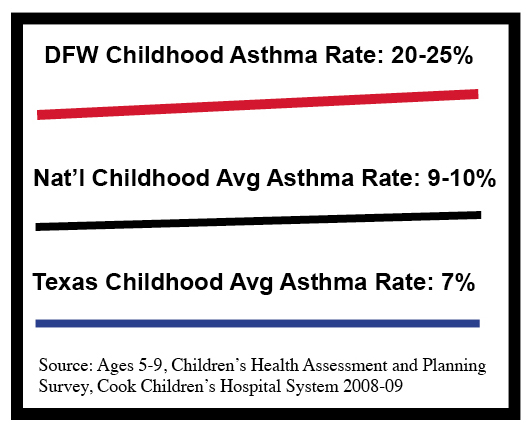 1. DFW has Epidemic Childhood Asthma Rates
1. DFW has Epidemic Childhood Asthma Rates
According to a first-of-its kind survey in 2008 by Cook Children’s Hospital, one out of every four DFW children ages 5-9 suffered from asthma. That was more than twice the national average, and more than three times the average for the state of Texas. Asthma is the most common cause of missed school days and is one of most common causes of Emergency Room visits and hospitalizations.
The DFW Hospital Council estimates nearly 1500 children in Dallas County visited an emergency room or were admitted to a hospital due to asthma in 2012. Dallas County has the highest number of child asthma hospitalization in the state.
According to EPA itself, a new 60 parts per billion (ppb) standard for ozone would eliminate roughly 1.8 million asthma attacks, 1.9 million missed school days, and 6,400 premature deaths nationwide – 95% of all ozone-related deaths. Few regions would benefit more from such a lower ozone standard than DFW.
2. It’s One of the Few Ways to Force Reductions in Harmful Air Pollution in Texas 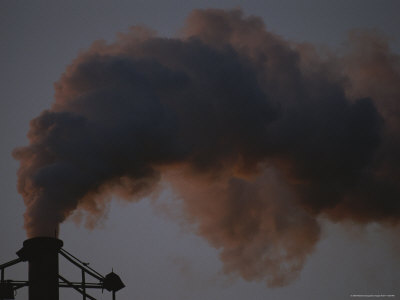
Texas is a place where industry rides rough shod over state regulators and citizens don’t have a level playing field to seek relief from the adverse health consequences of air pollution. Tougher federal ozone standards are one of the only ways to reduce air pollution from large local sources like the cement kilns in Midlothian, gas facilities in the Barnett Shale, and coal plants in East Texas.
Lower federal ozone standards over the last two decades, combined with grassroots campaigns have resulted in the lower volumes of smog pollution from the Midlothian cement kilns, plus reductions in other kinds of harmful pollution from the kilns as well, like particulate matter, and carcinogens. A new 60 ppb ozone standard would mean the kilns would have to add state-of-the-art controls to bring down those totals even more – to as much as 90% reductions. The same is true with the East Texas coal plants and with polluting gas facilities. To get down to 60 ppb ozone levels in DFW could mean deep cuts from the largest sources of industrial air pollution in North Texas. Something that probably won’t happen without a new, lower federal ozone standard.
And that won't happen without a lot of you showing up on Thursday to say you want and need cleaner air to breathe. Reserve your 5-minute speaking slot now. It's a good investment if you live in Texas.
Don’t put away those gas masks yet: EPA’s National Ozone Public Hearing is Next Thursday in Arlington
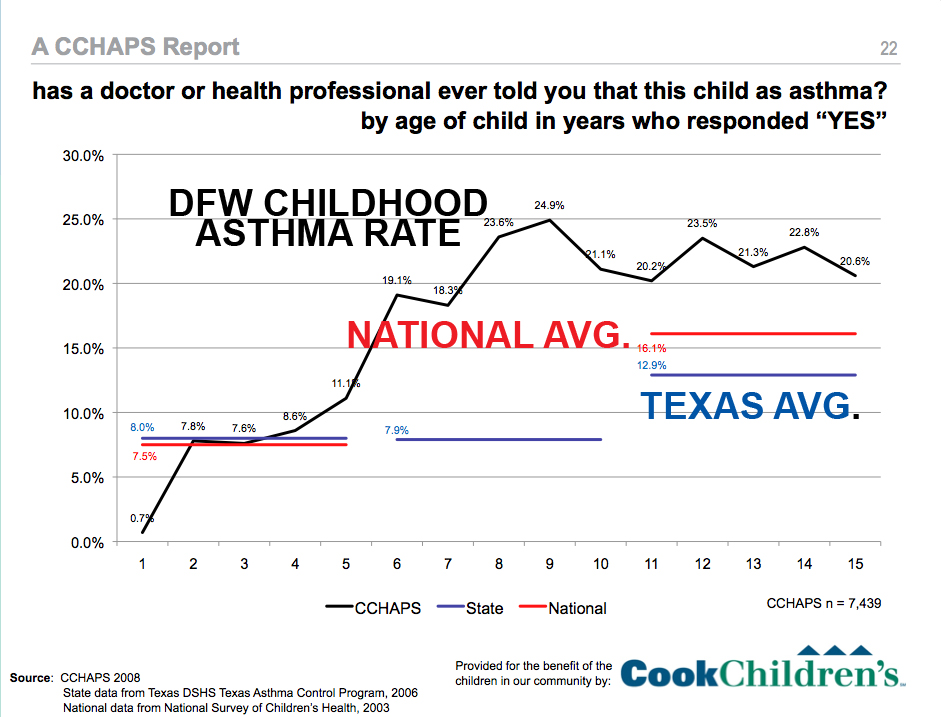
All Day NATIONAL Public Hearing on a New Federal Ozone Standard
Thursday, January 29th, 9am to 7:30 pm
Arlington City Hall, 101 W. Abram
(To secure a 3-minute speaking slot, e-mail Eloise Shepard and ask for one in the time period most convenient for you. Slots are going fast (and not necessarily to citizens), so do it asap: shepherd.eloise@epa.gov)
It's Round Two of January's clean air public hearing marathon, and the biggest has been saved until last.
One of only three national public hearings on lowering the federal ozone, or smog standard, is taking place here in DFW, at Arlington City Hall all day next Thursday January 29th, from 9 am to 7:30 pm.
Last week saw a state-sponsored hearing on another TCEQ do-nothing DFW clean air plan. But the state wouldn't even have to pay lip service to such plans were it not for the requirement to meet a federal ozone level and the region's inability to do so over the last two decades.
Lowering the federal ozone level means it will be tougher in the future for the state to claim it doesn't have to implement any new pollution controls on cement kilns, coal plants, or gas facilities. More importantly, enforcement of a tougher standard means better public health: fewer "bad air days," fewer asthma attacks, fewer trips to the emergency room because your child can't breath, and fewer deaths caused by dirty air.
That's important because reports like the child heath survey from Cook Children's hospital in 2009 showed that childhood asthma rates in DFW were twice the state average and almost 10% higher than the national average. It called the prevalence of asthma among local children an "epidemic."
Currently, the national ozone standard is 75 parts per billion (ppb) – which DFW is still at least three years away from reaching even under the rosiest of scenarios. (Right now our average is 81 ppb, and that's only because of a wetter and cooler summer in 2014). But that 75 ppb number is a political compromise – not one grounded in science. Based on public health studies the EPA's own independent board of specialists has recommended a range of 60 to 70 ppb at least three times since 2008, with an emphasis on the lower end of that range. Now it looks as if the EPA is finally willing to follow through on that recommendation.
EPA's national ozone standard sets the goal of cleaner air that every state must work toward. It drives all new clean air plans. like the one the state of Texas is proposing for DFW right now. The lower the standard, the more pollution has to be reduced. The more pollution has to be reduced, the more controls have to be added to major sources of air pollution to get that reduction. That's how you get long-term clean air progress in states like Texas that refuse to act on their own.
A significant reduction in the federal standard – from 75 (ppb) to as low as 60 ppb would make it much, much harder for Texas to avoid new controls on industry. To give you some idea of how much harder, consider that the state's "plan" for compliance with the current 75 ppb level is completely dependent on a new EPA gasoline mix coming onto the market in 2017. Even then, it's own estimates say that it won't get down below 75 at least three or four monitoring sites. Just one monitor site out of compliance means the whole region is in violation. Short of a huge rise in the use of electric cars, more huge decreases in vehicle pollution aren't expected. Additional significant drops in smog that would be required under a new, lower standard would have to include controls on major industrial sources – like the cement kilns, coal plant and, yes even gas facilities.
When you have a much lower ozone standard, you have to reduce smog by addressing ALL sources of air pollution.
Finding a way to comply with a lower national ozone standard is how more modern pollution controls were mandated almost a decade ago at the Midlothian cement plants. Meeting that new ozone standard meant pollution from the kilns had to be reduced and that made it more possible for Downwinders' "Green Cement" campaign to work with local governments. Today, there are no obsolete "wet kilns" left in Texas – they've all been replaced with more modern dry kiln operations. This has resulted in a reduction of hundreds, even thousands, of tons of smog-forming air pollution from these huge sources every year. We still have to require state-of-the-art Selective Calaytic Reduction (SCR) on the kilns, but they're releasing far less pollution than they were even five years ago because they've had to comply with a new federal ozone level.
With a new, lower ozone standard, the same could be true of new controls on gas facilities, like the 650 large compressors in North Texas, and the East Texas coal plants. That's why it's important for Texas residents to fight for the lowest possible standard this time around. When you testify, please make sure you request a new standard of NOT MORE THAN 60 PARTS PER BILLION.
According to a recent EPA staff analysis, an ozone standard of 60 ppb would reduce asthma deaths in the US by 95%, compared to only a 50% reduction under a 70 ppb level. If you want air that can eliminate all but a small fraction of respiratory problems associated with outdoor pollution, you need to press for a 60 ppb standard.
Needless to say industry is fighting back hard against such a standard, using its usual doom and gloom forecasts of economic hardship. This is the same argument that was used against the current ozone standard – the one we have now in the middle of the biggest economic boom in a decade. In fact, the technology for bringing down pollution levels currently exists in many industries – including kilns, coal plants and compressors. It's not experimental and it's not too expensive to use, as demonstrated by its use right now in those industries. We just have to require its use in states like Texas that are refusing to implement progress. That's why this new standard is so important – it will make the state take action it would not otherwise take. It's one of the only ways citizens who care about cleaner air in Texas can force progress.
Likewise, the Texas Commission on Environmental Quality's own toxicologist, Michael "Smog Ain't Bad For You" Honeycutt will also be testifying. TCEQ knows that a lower standard will force its hand on new controls. It will be pulling out all the stops to use its influence and that of sympathetic elected officials to scuttle any change. Using ideologically-based arguments supported by industry-financed studies, the TCEQ will say there are no real benefits to reducing DFW smog. Those of you that know better have to show up and say so.
Speaking slots for the 29th are going very fast. Industry will be well-represented. Please don't get left out. We need your voice that day to call for a 60 ppb national ozone standard. E-mail the EPA at shepherd.eloise@epa.gov and reserve your time today.
